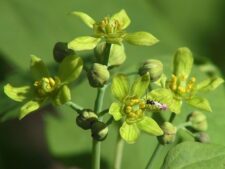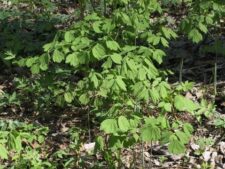
This native, erect perennial grows from 1 to 3 feet tall. Larger plants have sets of 3 or 4 compound leaves arising in a whorl from a single point on the stem. Each leaf is usually divided into 3 leaflets with 2-3 lobes (A,D). Rising above and separate from the leaves is the flower stalk bearing a panicle of green to yellow-green flowers less than 1/2 inch wide (B). At the base of the 6 narrow petal-like sepals, the most visible part of the flower, are the small, greenish petals and a circle of yellow anthers. The colorful blue fruits are actually seeds with a fleshy deep blue covering. The photo (C) shows green fruits because ours dropped or were eaten before acquiring the color responsible for its common name.
Grows in moist, deciduous woods, flowering in April and May. At Neale Woods, Blue Cohosh is uncommon on the Rock Creek terrace near Paw Paw Trail.
The Omahas considered preparations from the root of this plant to be their most effective treatment for fevers. Other Native Americans used it to facilitate childbirth. It was widely used by early settlers for a variety of disorders.
Other common names include Blueberry Root and Blue Ginseng.
The content of NatureSearch is provided by dedicated volunteer Naturalists of Fontenelle Forest who strive to provide the most accurate information available. Contributors of the images retain their copyrights. The point of contact for this page is: Neal Ratzlaff.



